What are PFAS?


Common questions about PFAS
PFAS can be found in everyday consumer products such as pizza boxes, nonstick cookware, and stain-and-water repellent clothing, including popular outdoor gear. They can also be found in some fire-fighting foams.
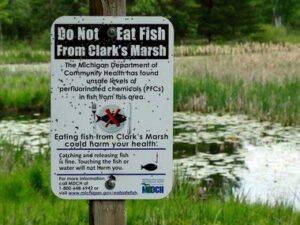
The primary exposure of concern is through drinking water and ingestion. Dermal contact is not deemed a significant risk at this time.
Eating fish caught from water contaminated by PFAS (PFOS, in particular) can be an exposure pathway. Fish are being collected from local lakes and rivers and tested for some of the PFAS chemicals. Michigan Department of Human and Health Services releases Eat Safe Fish Guides each spring, and emergency advisories as needed. In water bodies with fish that have a PFOS guideline, touching the fish or water and swimming are not considered a health concern as PFAS do not move easily through the skin. An occasional swallow of river or lake water is also not considered a health concern. Click here for Consumption Guidelines for Fish with Elevated PFOS Levels.
In addition, in October 2018, the Michigan Department of Health and Human Services (MDHHS) issued a ‘Do Not Eat’ advisory for deer taken within approximately five miles of Clark’s Marsh in Oscoda Township. The advisory is due to high levels of PFOS found in a single deer taken about two miles from Clark’s Marsh, which borders the former Wurtsmith Air Force Base that has known levels of high contamination. As of January 2019, no other advisories on eating deer at any of the other locations tested for PFAS exist in Michigan. The State is actively sampling in other locations to determine if there is the potential for similar situations.
People can also be exposed to PFAS chemicals if they are released during normal use, biodegradation, or disposal of consumer products that contain PFAS. As a result, the average person has been exposed to some level of PFAS during their lifetime. However, having PFAS in your blood does not necessarily mean that you will become ill from PFAS.
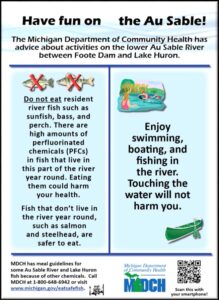
The U.S. Environmental Protection Agency (EPA) is particularly concerned about the long-chain PFAS chemicals. Studies on shorter chain chemicals suggest they are less bioaccumulative and less toxic than the long-chain PFAS. Industry has collaborated with the EPA to undertake several voluntary phase-outs of the long-chain chemicals. There are a limited number of ongoing uses of the long-chain chemicals still available in existing stocks and from companies not participating in the PFOA phase-out program. In addition, exposure could occur via goods imported from countries where PFOS and PFOA are still used. Furthermore, alternatives are polyfluoroalkyl substances with shorter fluoroalkyl chains than C8, which have not yet been proven to be any safer.
The U.S. Food and Drug Administration (FDA) directed food companies to stop the use of PFAS with chain lengths of eight or more carbons (a specific group of PFAS that includes PFOS and PFOA) for paper and paperboard food contact materials in 2010. This includes fast-food wrappers, to-go boxes, microwave popcorn bags, and pizza boxes. Some other PFAS chemicals are still allowed for these materials, however, the FDA regulates and limits the amount manufacturers can use and for what specific purposes.


PFAS bioaccumulate and are incredibly persistent in the environment. This means the amount of PFAS that build up in organisms and in ecosystems over time do not break down in the soil or water environment. Some evidence exists for adverse health effects, such as higher risk of various cancers, liver/kidney abnormalities, impacts on the immune system, and thyroid conditions. However, these are not completely understood and research continues to be conducted to understand how the timing, duration, and concentrations of exposure play a role on the effects of PFAS.
Currently, the EPA’s recommended lifetime health advisory limit is set at 70 parts per trillion (ppt) for PFOA and PFOS (the two best studied PFAS compounds). Currently, the EPA has not set health advisory levels for the other PFAS chemicals. Michigan has adopted a clean up standard for contaminated groundwater supplies of 70 ppt for PFOS and PFOA, based on the EPA standard.
However, this number may be too high. A recent draft study by the Centers for Disease Control and Prevention (CDC) found that, for certain PFAS, health issues began presenting themselves at significantly lower levels than the current EPA recommendation of 70 ppt. The Association of Drinking Water Administrators expects these study results will lower the recommended safe level to 7 ppt for PFOS and 11 ppt for PFOA, seven to ten times lower than the EPA’s current recommendation.
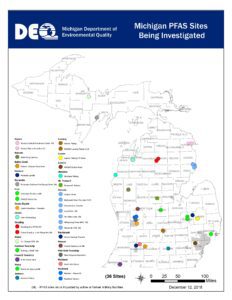
The State of Michigan is taking a proactive approach in identifying areas with PFAS contamination. The State established the Michigan PFAS Action Response Team (MPART) for a rapid and multidepartmental response. MPART is requiring all public water systems and 461 schools to test their water supplies and have asked wastewater treatment plants to test their discharge. Furthermore, Michigan is getting its labs ready for PFAS testing, helping to reduce the time it takes to get back certified results. They are also testing different fish and recommending limited or no consumption of certain species due to PFAS contamination. All this information is available to the public on the Michigan PFAS Response website.
Currently, the status of PFAS in the waters of our service area is relatively unknown. Public drinking water systems are being tested across the State, with Emmet, Charlevoix, Antrim, and Cheboygan County’s systems tested in August of 2018. Results for Antrim, Cheboygan, and Emmet County show no detectable levels of PFAS. The City of Charlevoix tested positive for PFAS, with levels of PFOA and PFOS between 2-4 parts per trillion (ppt). The Walloon Lake Water System in Charlevoix County had non-detectable levels of PFOA and PFOS, but showed ranges between 2-19 ppt for other tested PFAS. The EPA has not set health advisory levels for the other PFAS compounds. Boyne Falls Public School tested positive for 7 ppt for PFOA and PFOS combined, well below the EPA lifetime health advisory level of 70 ppt. However, this is only for communal drinking water systems. Data for lakes, rivers, and individual wells are very limited.
 There are some treatment options available for residents who are concerned about their drinking water. In-home water filtration systems are recommended by the Michigan Department of Health and Human Services to lower the levels of PFAS in drinking water. Both granular activated carbon (GAC) and reverse osmosis (RO) filters can reduce PFAS substances. An NSF P473 approved filter should be used. Filters must be selected, operated, and maintained to manufacturer’s specifications.
There are some treatment options available for residents who are concerned about their drinking water. In-home water filtration systems are recommended by the Michigan Department of Health and Human Services to lower the levels of PFAS in drinking water. Both granular activated carbon (GAC) and reverse osmosis (RO) filters can reduce PFAS substances. An NSF P473 approved filter should be used. Filters must be selected, operated, and maintained to manufacturer’s specifications.
Contact your local water supplier and ask for information on PFOA and PFOS in their drinking water and request a copy of their Consumer Confidence Report.
The Michigan Department of Environment, Great Lakes, and Energy (EGLE) Drinking Water Laboratory will begin testing for Per- and Polyfluorinated Alkyl Substances (PFAS) in drinking water this Fall 2019. The cost of this testing will be $290.00 for one sample. This new testing following EPA Method 537.1 has been in development as part of an overall response by the State of Michigan to address PFAS and help protect the health of Michigan’s citizens, visitors, and environment.
Test kits will be available for order or pick up at the EGLE Drinking Water Laboratory beginning Monday, September 30, 2019. The new PFAS sample collection kit will include:
3 – 250ml sample bottles with preservative
1 – 250ml Field Reagent Blank bottle (A) with preserved water
1 – 250ml Field Reagent Blank bottle (B) empty
5 – Hard blue ice packs
1 pair of nitrile gloves for collecting samples
Sample collection instructions
Request For Water Analysis – PFAS form
Styrofoam shipping container and box
Return UPS shipping label
Contact the Laboratory at 517-335-8184 with additional questions about this new PFAS testing.
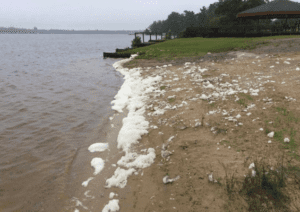
Some of the foam observed along shorelines of lakes and rivers are indicative of PFAS. However much of this foam observed is a natural phenomenon from the breakdown of organic material. Natural foam is usually persistent, especially during the fall season as leaves and other organic material enter nearby waters. Foam from natural decomposition is off-white and/or brown and may have an earthy or fishy aroma, as opposed to potential PFAS related foam that has been described as bright white in coloration, light and tends to pile up like shaving cream, and slimy or sticky to the touch.
It is recommended that you avoid foam on the water during recreational activities. Foam on lakes and rivers may have much higher amounts of PFAS than the water and could be a health risk, especially if swallowed. PFAS do not move easily through the skin, but it’s best to rinse off after contact with foam and bathe or shower after the day’s activities. Additionally, do not let your pets, especially dogs, swallow the foam. Dogs that come in contact with foamy water should be rinsed off thoroughly with fresh water.
What is the Watershed Council doing about PFAS?
Since little information is known about the presence of PFAS in surface waters of our region, the Watershed Council monitored for PFAS during the spring and fall of 2019. Water samples were collected from water bodies in Emmet and Charlevoix Counties near locations with the potential to contain PFAS (i.e., landfills, airports, etc.). Each sample was analyzed for 14 of the common PFAS chemicals at the University of Michigan Biological Station. Monitoring efforts were supported by the Petoskey Harbor Springs Area Community Foundation and the Charlevoix County Community Foundation.
Click here to see the results of the monitoring efforts:
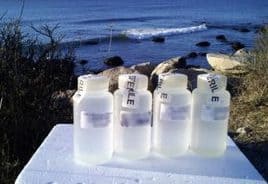
We are also working with our partners at Michigan Environmental Council advocating for policy solutions to ensure there is a system in place to protect human health and the environment against PFAS and other emerging contaminants of concern. The policy solutions we are advocating for are listed below and address public health, transparency, cleanup, and accountability.
Public Health
- Establish a drinking water standard for PFAS under the Michigan Safe Water Drinking Act by creating a Maximum Contaminant Level (MCL) for PFAS that uses the best science available. Based on a Center for Disease Control (CDC) draft study, this would indicate 7 ppt for PFOS and 11 ppt for PFOA, but this may change with more information.
- Reassess the cleanup standard for PFAS in Part 201 of the Natural Resources and Environmental Protection Act due to the aforementioned CDC draft study and emerging health research.
- Fund and implement point-of-use filters for individual residents in impacted communities.
- Establish a grant program to add needed treatment technologies to public water systems, like granular activated carbon filtration processes.
- Fund the connections of residential homes to public water systems when PFAS are found in their wells, if this is available.
- Ensure adequate revenue to address ongoing PFAS responses around the state.
Transparency
- Require EGLE to publish all test results and information gathered from other levels of government.
- Create and update a map with all known contaminated groundwater plumes in Michigan and make it available to the public.
Cleanup
- Keep in place the rule in Part 201 of the Natural Resources and Environmental Protection Act that allows new cleanup standards to be set quickly for chemicals not currently regulated (which is virtually all PFAS).
- Ensure a sustainable funding source for contaminated site remediation.
Accountability
- Michigan should lead a combined effort by the 50 States to marshal the needed political forces to make the federal government, especially the Department of Defense, fund cleanup and remediation.
- Change our laws so that they hold not only the party who caused the release of chemicals responsible, but also include any company that is aware of the dangers related to the chemicals it produces and sells but fails to disclose them to the public.
Local PFAS Sites and Areas of Interest
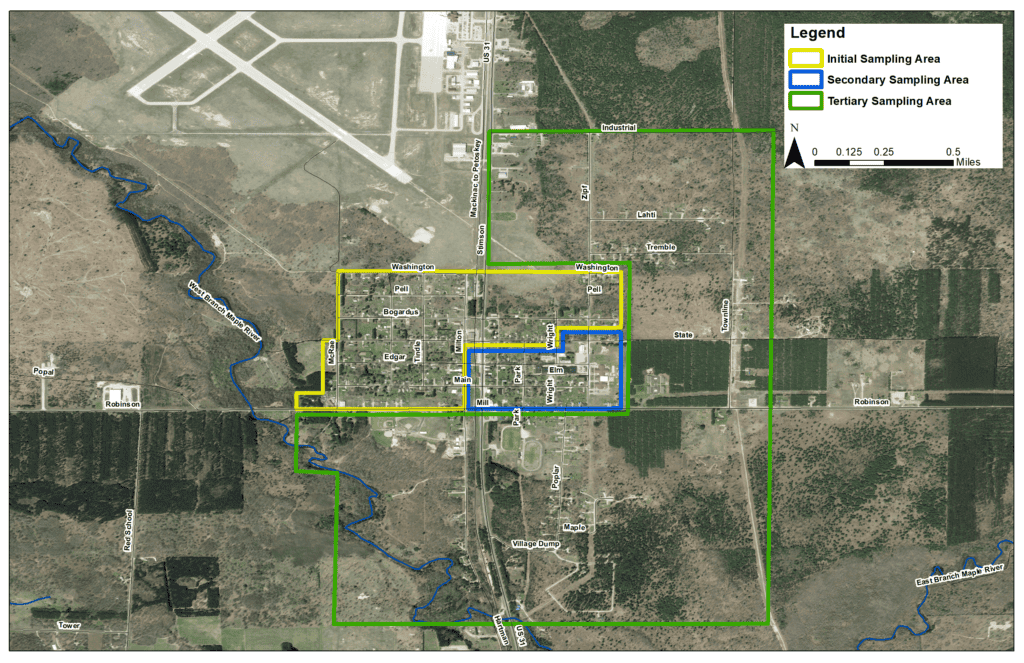
Elevated PFAS levels were detected in a private well in Pellston after the owners chose to have their water tested for the substance. The results showed 13 part per trillion (ppt) of PFOA, 124 ppt of PFOS, and 226 ppt for another kind of PFAS, PFHxS.
It’s the first site in Emmet County known so far to have PFAS levels in that range.
Michigan currently has 72 locations designated as “PFAS sites,” where PFAS testing has shown levels above 70 ppt. Pellston has not been designated as such yet, but it could be depending on the results of investigations.
For now, though, the priority is to determine if there is an immediate risk to area residents. The state will offer free sampling to homes that could be impacted by the recent Pellston contamination reports.
In addition, the Health Department of Northwest Michigan (HDNW) representatives secured a supply of bottled water and a delivery point. The water is available to residents with elevated levels of PFAS in their drinking water and water vouchers have been provided to residents within the village of Pellston.
An agreement was reached with a local plumbing contractor to install household filter systems and provide replacement cartridges to individuals with detectable levels of PFAS chemicals as a precautionary action.
If you live within the sampling area and have not had access to the form, download the sampling request form below. You must download the form to your computer before filling it out.
Testing PFAS to Protect Public Health
Return the form by email to MacDonaldL1@Michigan.gov or mail to:
Gaylord EGLE Office
Attn: Leah MacDonald
2100 West M-32
Gaylord, MI 49735
More information can be found at nwhealth.org and www.michigan.gov/pfasresponse.
The Charlevoix Municipal Well site is located on Lake Shore Drive in Charlevoix. This site was a former Superfund Site where groundwater was contaminated by industrial chemicals – TCE and PCE. Groundwater clean-up activities resulted in EPA removing the site from the Superfund Program’s National Priorities List (NPL) in 1993. Operation and maintenance activities are ongoing to address the industrial chemicals. PFAS sampling was completed by Michigan Department of Environment, Great Lakes, and Energy (EGLE) in October 2021 and three monitoring wells were found to contain PFAS analytes that exceeded groundwater clean-up criteria. The highest results were 200 ppt PFHxS and 15 ppt PFOA. EPA and EGLE will be conducting additional field work on the site in the spring (2022). The work will include additional soil and groundwater investigations throughout the city.
The groundwater flow direction is to the northwest or northeast. It is dependent upon the influence of Lake Michigan or Round Lake respectively.
Residential well sampling has not been completed because municipal drinking water is provided to residents of the city. The City of Charlevoix operates a Direct Filtration Water Treatment Facility which uses water from Lake Michigan.
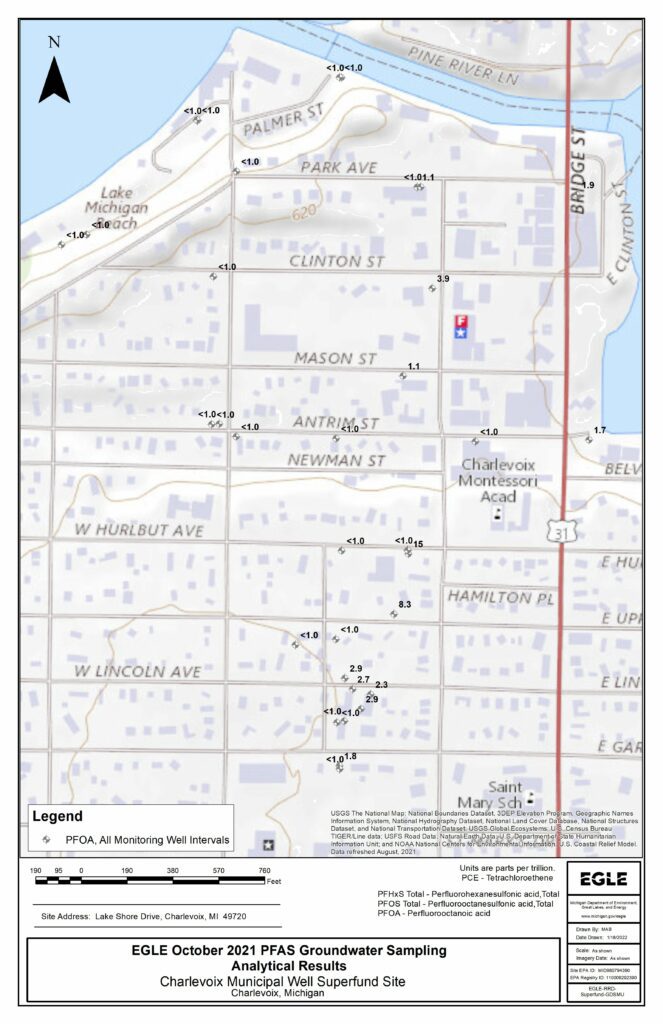
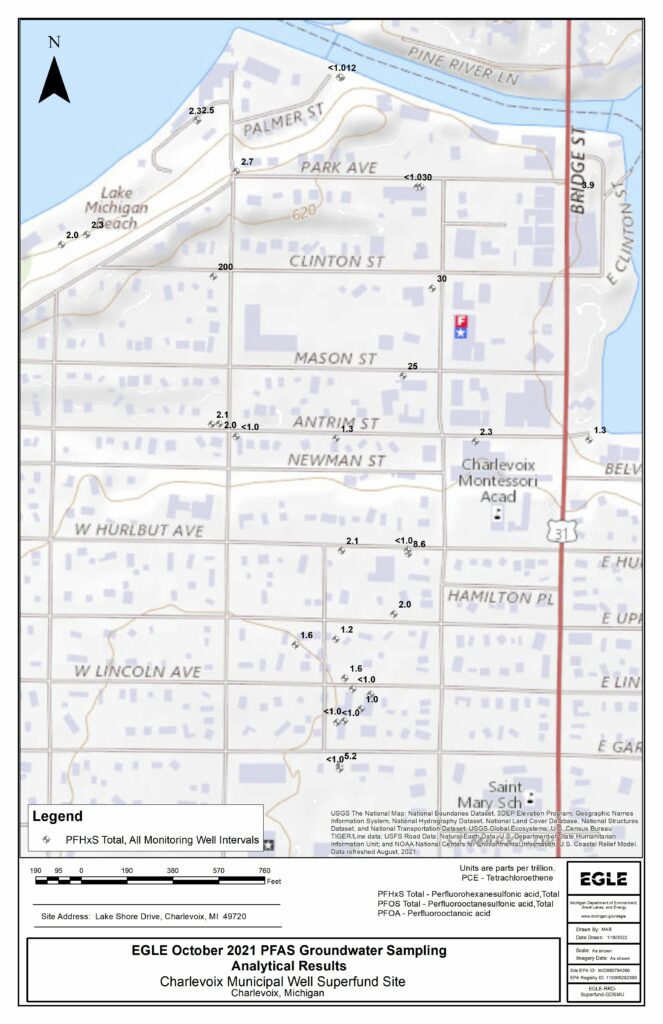
The Kalkaska Wastewater Treatment plant (WWTP) is located at 1005 Island Lake Road NW and is permitted to discharge 219,000,000 gallons of treated municipal wastewater per year. The treatment plant utilizes active sludge treatment that discharges to rapid infiltration seepage beds. The treated wastewater is discharged to the ground under a state Groundwater Discharge Permit issued to the Kalkaska WWTP. The wastewater treatment facility was upgraded in 2003. The facility receives municipal wastewater from the Village of Kalkaska.
Groundwater samples were collected by EGLE in November 2022. The highest result was 20.9 ppt for PFOS (compared to 16 ppt).
Note: Public and private municipal wastewater treatment plants do not produce or use PFAS. These plants receive residential, commercial, and sometimes industrial wastewater that may contain PFAS. Conventional wastewater treatment plants are not designed to treat for PFAS, therefore PFAS may pass through the treatment system to surface waters (i.e., lakes, rivers, etc.) and groundwater.
The groundwater flows to the west/northwest. At this time no waterbodies have been impacted.
In early June 2023, EGLE sampled one residential well near the WWTP. Once these results, and the results of groundwater monitoring of the entire groundwater well network are received and evaluated, EGLE, DHHS, and the local health department will determine if additional residential wells should be sampled.
Key II Industrial Building is located at 603 Bridge Street. From the 1950s to the 1980s, the site was used as a tool and die shop. Afterwards, it was an antique shop and retail facility until late 2020. Since then, it has operated as a watercraft sale and rental facility. EGLE reviewed a Baseline Environmental Assessment (BEA) on June 28, 2021 that was conducted for potential redevelopment of the property. Two temporary monitoring wells had concentrations of PFAS exceeding groundwater cleanup criteria (indicated by yellow highlights below). Monitoring well TW-6 exceeded groundwater cleanup criteria for PFOS and PFOA and groundwater surface water interface (GSI) criteria for PFOS. Monitoring well TMW-4 exceeded GSI criteria for PFOS.
Analyte | TMW-6 (ppt) | TMW-4 (ppt) | |
PFOA | 26 | Non-Detect | |
PFOS | 160 | 13 | |
PFOS-LN | 120 | Non-Detect | |
PFOS-BR | 36 | Non-Detect | |
PFPeA | 11 | Non-Detect | |
Other PFAS | Non-Detect | Non-Detect |
Sampling Results
Groundwater monitoring well results are compared to EGLE Part 201 criteria for 7 PFAS compounds effective 12/21/2020: PFOS (16 ppt), PFOA (8 ppt), PFNA (6 ppt), PFHxS (51 ppt), PFHxA (400,000 ppt), PFBS (420 ppt), and HFPO-DA (370 ppt).
Groundwater Surface Water Interface Criteria is compared to Rule 57 non-drinking water values of 12 ppt for PFOS and 12,000 ppt for PFOA.
Municipal water is available. There are no shallow private wells downgradient from this site.
Groundwater flow is to the east towards Elk Lake.


